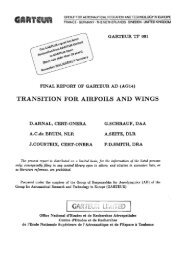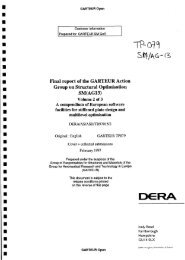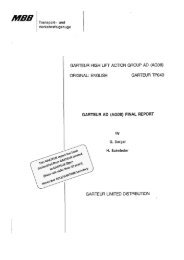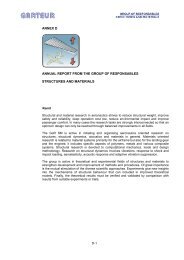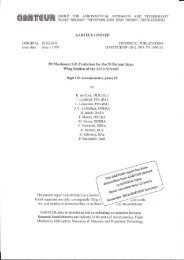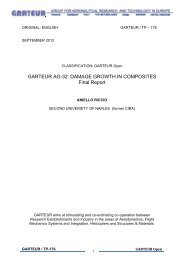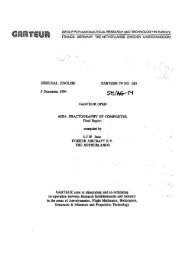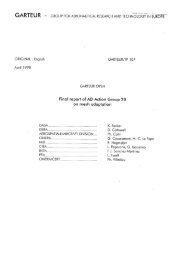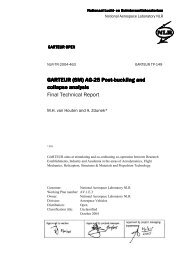Cadmium Substitution - garteur
Cadmium Substitution - garteur
Cadmium Substitution - garteur
Create successful ePaper yourself
Turn your PDF publications into a flip-book with our unique Google optimized e-Paper software.
GARTEUR LIMITED<br />
c) Exposure to 100% humidity<br />
The exposure of panels plated with cadmium, zinc alloys and the two metallic ceramic<br />
coatings Delta-tone and SermeTel to 100% humidity was investigated by Fokker. The<br />
tests were terminated after 2000 hours and the results obtained are presented in table<br />
C7. Rust spots were only found on the Delta-tone sample, all the remaining test panels<br />
survived the 2000 hour exposure period.<br />
C.3.1.2<br />
Outdoor exposure<br />
Results of the outdoor exposure trials on non-scribed panels are given in table C5. Trials<br />
and Schiphol were terminated after 462 days. During that time only the electrodeposited<br />
zinc-nickel coating showed evidence of red rust. Tests conducted at the DERA Fraser<br />
marine exposure site were continued for two years. During that period evidence of<br />
rusting was found on all the aluminium coatings and the non-passivated zinc-nickel<br />
coating. The two metallic-ceramic coatings, Delta-tone and SermeTel, and the<br />
electrodeposited zinc-cobalt-iron coatings showed no evidence of rusting.<br />
C.3.1.3<br />
Electrochemical measurements<br />
The polarisation studies were used to estimate the corrosion current density for each of<br />
the coatings in sodium chloride solution. The results obtained are presented in table C6.<br />
As found in the accelerated tests, passivation treatments generally decreased the<br />
corrosion rate of the coating. The aluminium based coatings had lower corrosion rates<br />
than the zinc rich deposits suggesting they possessed better barrier properties.<br />
C.3.2<br />
Sacrificial properties<br />
Accelerated corrosion tests and outdoor exposure trials on scribed panels were used to<br />
compare the relative sacrificial properties of the coatings. The time to the appearance of<br />
red rust in the scribe was used as a measure of the coatings ability to cathodically<br />
protect the substrate at areas where the coating is damaged.<br />
C.3.2.1<br />
Accelerated corrosion tests<br />
Results of the neutral salt fog, MASTMAASIS and 100% humidity tests are given in<br />
tables C7, C8 and C9 respectively. The data refer to the occurrence of red rust within<br />
thescratch region. In the case of the zinc rich coatings, the time to red rust was<br />
comparable with cadmium plating. However the aluminium coatings generally showed<br />
relatively poor performance, with red rust being detected in the salt spray test after<br />
relatively short exposure periods. Variable results were obtained with the SermeTel<br />
coatings. These were considerably thicker than the zinc alloy and aluminium alloy<br />
coatings and may have had an influence on the results.<br />
C.3.2.2<br />
Outdoor exposure trials<br />
Outdoor exposure data obtained from four test sites are summarised in table C10. The<br />
results indicate that electrodeposited zinc-nickel coatings are less effective than<br />
cadmium plating in protecting the scribed area. The zinc-cobalt-iron system appears very<br />
similar to cadmium in performance in both marine and relatively rural environments The<br />
aluminium based schemes including SermeTel 984 were the least efficient coatings and<br />
in the most favourable case did not delay the onset of rusting for more than six months.<br />
This suggests that in a marine environment, sacrificial coatings are more effective than<br />
simple barrier coatings.<br />
Page 60<br />
GARTEUR SM/AG17 TP128




